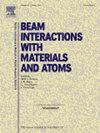Surface/interface investigation of positron diffusion in electrochemically reduced nanoporous Au from dealloyed nanoporous Au
IF 1.4
3区 物理与天体物理
Q3 INSTRUMENTS & INSTRUMENTATION
Nuclear Instruments & Methods in Physics Research Section B-beam Interactions With Materials and Atoms
Pub Date : 2025-01-16
DOI:10.1016/j.nimb.2025.165624
引用次数: 0
Abstract
Positron lifetime measurements, variable energy positron beam Doppler broadening analyses, and electron microscopy studies were performed to investigate morphological evolution and its influence on positron diffusion behavior in electrochemically reduced nanoporous Au. Samples were obtained by potential cycling of as-dealloyed nanoporous Au within reduced potential intervals. Electron microscopy revealed significant morphological changes, resulting in a random structure composed of Au ligaments. Positron lifetime and S(EP) measurements provided insights into effective diffusion length of positrons, which scaled with the ligament diameter with an exponent of ∼0.5, contrasting with the behavior observed in as-dealloyed nanoporous Au. Positronium fraction calculations showed preferentially positron diffusion toward the surfaces/interfaces of the ligament pore networks. Nanoindentation measurements of Young’s modulus correlated with the microstructure and defect characteristics of the reduced nanoporous Au. These findings enhance our understanding of how variations in vacancy defects associated with ligament surfaces/interfaces substantially impacts the mechanical properties of nanoporous Au assemblies.
电化学还原纳米孔金中正电子扩散的表面/界面研究
采用正电子寿命测量、变能正电子束多普勒展宽分析和电子显微镜研究了电化学还原纳米孔金的形态演变及其对正电子扩散行为的影响。在减小的电位区间内,通过电位循环获得了合金化纳米孔金样品。电镜下观察到明显的形态变化,形成由金韧带组成的随机结构。正电子寿命和S(EP)测量提供了对正电子有效扩散长度的深入了解,其与韧带直径成比例,指数为~ 0.5,与在合金纳米孔Au中观察到的行为形成对比。正电子分数计算表明,正电子优先向韧带孔网络的表面/界面扩散。杨氏模量的纳米压痕测量与还原纳米孔金的微观结构和缺陷特征相关。这些发现增强了我们对与韧带表面/界面相关的空位缺陷的变化如何实质性地影响纳米孔Au组件的机械性能的理解。
本文章由计算机程序翻译,如有差异,请以英文原文为准。
求助全文
约1分钟内获得全文
求助全文
来源期刊
CiteScore
2.80
自引率
7.70%
发文量
231
审稿时长
1.9 months
期刊介绍:
Section B of Nuclear Instruments and Methods in Physics Research covers all aspects of the interaction of energetic beams with atoms, molecules and aggregate forms of matter. This includes ion beam analysis and ion beam modification of materials as well as basic data of importance for these studies. Topics of general interest include: atomic collisions in solids, particle channelling, all aspects of collision cascades, the modification of materials by energetic beams, ion implantation, irradiation - induced changes in materials, the physics and chemistry of beam interactions and the analysis of materials by all forms of energetic radiation. Modification by ion, laser and electron beams for the study of electronic materials, metals, ceramics, insulators, polymers and other important and new materials systems are included. Related studies, such as the application of ion beam analysis to biological, archaeological and geological samples as well as applications to solve problems in planetary science are also welcome. Energetic beams of interest include atomic and molecular ions, neutrons, positrons and muons, plasmas directed at surfaces, electron and photon beams, including laser treated surfaces and studies of solids by photon radiation from rotating anodes, synchrotrons, etc. In addition, the interaction between various forms of radiation and radiation-induced deposition processes are relevant.

 求助内容:
求助内容: 应助结果提醒方式:
应助结果提醒方式:


